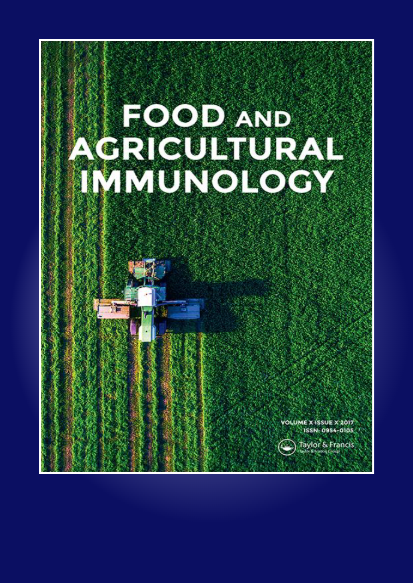Development of a sensitive monoclonal antibody-based immunochromatographic strip for neomycin detection in milk
IF 2.1
3区 农林科学
Q3 CHEMISTRY, APPLIED
引用次数: 4
Abstract
ABSTRACT To improve the detection sensitivity of neomycin (NEO) in milk, we produced a sensitive monoclonal antibody (mAb) against NEO and developed a lateral flow immunoassay based on amorphous carbon nanoparticles (ACNPs-LFA). First, we conjugated NEO to carrier protein to prepare mAbs. We obtained six mAbs: mAb 1C6, mAb 1D3, mAb 2D3, mAb 4D5, mAb 5D1, and mAb 5H1. We characterised the mAbs by indirect competitive enzyme-linked immunosorbent assay and selected the most sensitive mAb based on the half-maximal inhibitory concentration (IC50). We selected mAb 4D5 (IC50 = 0.15 ng/mL) for the development of LFA. MAb 4D5 was labelled with ACNPs (ACNPs-mAb 4D5) by electrostatic absorption. Under optimised conditions, 5.4 μg mAb 4D5 coupling with 1 mL ACNPs, NEO-OVA at concentration of 80 μg/mL, 3 μL ACNPs-mAb 4D5 were used to develop LFA. The cut-off value was 8 ng/mL. Therefore, our developed ACNPs-LFA is suitable for on-site detection of NEO residues.基于单克隆抗体的敏感牛奶新霉素免疫层析条的研制
摘要为了提高牛奶中新霉素(NEO)的检测灵敏度,我们制备了一种针对NEO的敏感单克隆抗体(mAb),并开发了一种基于无定形碳纳米颗粒(ACNPs-LFA)的侧流免疫测定法。首先,我们将NEO与载体蛋白偶联以制备单克隆抗体。我们获得了六种mAb:mAb 1C6、mAb 1D3、mAb 2D3、mAb4D5、mAb 5D1和mAb 5H1。我们通过间接竞争性酶联免疫吸附测定法对mAb进行了表征,并根据半数最大抑制浓度(IC50)选择了最敏感的mAb。我们选择了mAb 4D5(IC50 = 0.15 ng/mL)用于LFA的发展。通过静电吸收用ACNPs(ACNPs MAb 4D5)标记MAb 4D5。在优化的条件下,5.4μg mAb 4D5与1 用80μg/mL浓度的ACNPs、NEO-OVA和3μL ACNPs mAb 4D5制备LFA。截止值为8 ng/mL。因此,我们开发的ACNPs LFA适用于近地天体残留物的现场检测。
本文章由计算机程序翻译,如有差异,请以英文原文为准。
求助全文
约1分钟内获得全文
求助全文
来源期刊

Food and Agricultural Immunology
农林科学-毒理学
CiteScore
5.30
自引率
6.70%
发文量
52
审稿时长
2 months
期刊介绍:
Food and Agricultural Immunology is an international open access journal publishing original immunological research with applications in food, agricultural, environmental and veterinary science. Submissions describing the use of immunological techniques and methods are particularly welcomed.
The journal aims to expand our understanding of the interactions at the interface of food and immune systems including studies on:
-Development of diagnostic systems – all types of ligand-based assays, e.g. antibody, aptamer
-Application of ligand-based assays for the detection or identification of molecules of interest in food science, agricultural research, veterinary investigations and clinical systems relating to food allergy or sensitivity to agricultural chemicals
-Effects of food on the immune system
-Studies on allergy and allergic reactions
-Investigations into food allergies
-Development of allergen-free food systems
-Development of novel assay formats
-Applications of assay systems to the monitoring of food items in relation to safety and labelling
-Food quality issues, e.g. speciation, adulteration and contamination
-Comparisons between different analytical techniques
The journal publishes research and review articles and is essential reading for food scientists, immunologists and all those concerned with the interaction between food and immune systems.
 求助内容:
求助内容: 应助结果提醒方式:
应助结果提醒方式:


